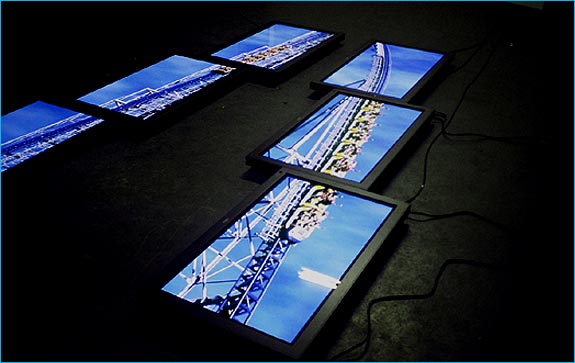|
|
|
 |

 |

"ARCADIA", 2000
Six-channel video installation, color with sound, DVD sources, Plasma displays. 2 powder-coated aluminum towers on steel base.
Towers - 400 x 105 x 16 cm.
Base - 240 x 200 x 5 cm.
Two identical 4 meter-high monolithic black metal towers stand facing each other. Each house three flat-panel video monitors exposed inwards through recessed windows arranged in a diagonal pattern. 35mm film originated footage of a roller coaster ride is presented as an observation of a contemporary mode of leisure and distraction.
The piece was filmed at the "Millennium Force" - the world's tallest and fastest roller coaster in Sandusky, Ohio, opened in May 2000. The riders are shown anticipating the ride during the painfully slow ascent as they are pulled up a track at a 45 degree angle, then bracing themselves for a 300 foot drop at over 90 miles per hour down the coaster's 80 degree incline.
The right-hand set of screens frame sequential views of the ride's ascent, while the opposing set of images shows on the free-fall portion of the ride. The timeline of the experience is fragmented by the way it is shot and presented, each screen showing only a segment of the roller coasters' trajectory. Furthermore, the physical layout of the towers creates a narrow "field of view" from which to observe the images. The proximity of the two monoliths places the viewer as an outsider; unable to physically occupy the sweet spot from which to best absorb the "excitement" created by the ride.
The "event" takes place somewhere between the two opposing structural and visual states of the installation. The passenger's body language and emotions are of the moments immediately before and after the ride reaches its unseen apex. The resonance between the two opposing moments (climb and fall) creates a theoretical third state - a state of equilibrium where maximum satisfaction can be theoretically sustained.
The central communication of cause and effect is emphasized using slow motion techniques to synchronize the coasters' movement in both the rise and fall. As presented, the 3 second 92 mile per hour drop takes over a minute in screen time - slow enough to observe the riders' reactions and movements and matching the speed of the ascent. This loop alternates with real-time descents, which cascade continuously down one set of screens, creating an endless loop with the speed of the rise remaining constant throughout.
The accompanying 5 channel audio track creates a complimentary sense of movement and emphasizes the tension between the two sets of images. Mechanical sounds accompany the ascent and counterpoint the descent, where overlapping speed-distorted samples of people's screams are sustained through the extended free-fall.
Photos by Charlie Samuels www.charliesamuels.com
|
|
  |
|
 |





